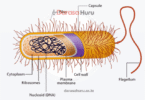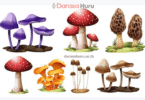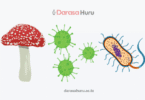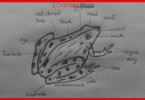Topic 3: Cell Structure and Organization – Biology Form One Notes New Syllabus
All living things are made up of cells. The cell is the basic functional unit of life. In this chapter, you will learn about the meaning of the cell, characteristics of the cell, and the functions of different parts of animal and plant cells. You will also learn the similarities and differences between plant and animal cells.
In addition, you will learn the concept of cell differentiation and its importance to the formation of tissues, organs, and organ systems. The competencies developed will enable you to learn better other biological processes.
THE CONCEPT OF CELL
The short history about discovery of a cell
The cell was first named and discovered by an English biologist called Robert Hooke in 1665 when he was observing a piece of cork under the microscope he had made.
Robert Hooke noticed that the cork was made up by many box- like units which were packed together to form a structure like a honeycomb. He called these units’ cells.
Hooke observed many other living materials and noted that they were also made up of cells.
Cell: Is the basic unit of life.
Cell theory
(a) All living things are composed of one or more cells.
(b) Cells are the basic unit of structure and functions of living things.
(c) All cells are produced from other cells
(d) Cells contain inheritable information which controls their activities.
(e) All cells are basically similar in chemical composition.
(f) All life processes take place in the cells.
Note: All living things or organisms are composed of one or more cells.
For example;
- Organisms that consist of a single cell are called Unicellular organisms.
- Organisms that consist of many cells are called Multicellular organisms.
TYPES OF CELLS
There are two main types of cells, namely:
i. Prokaryotic cells
ii. Eukaryotic cells
1. PROKARYOTIC CELLS
Prokaryotic cell is the type of cell in which nuclear materials are not bound with membrane. Example: Bacteria cell
Prokaryotic organisms: are single-celled organisms
Prokaryotic organisms are also called prokaryotes Example: bacteria and blue-green bacteria
Characteristics of prokaryotic cells.
i. They have no true nuclei.
ii. They lack membrane- bound organelles such as mitochondria
iii. They are smaller in size than eukaryotic cells.
iv. They have few cell organelles
v. Some of them they have flagellum for movement
vi. They have circular DNA
vii. They have different shapes like rod shape, spiral shaped, spherical shaped, comma shaped and spiralchaete shape
2. EUKARYOTIC CELLS
Eukaryotic cells are cells whose nuclei are bounded by nuclear membrane. Example: plant cells, animal cells, fungi cells, protoctists cells. Eukaryotic organisms: are organisms which contain eukaryotic cells. Eukaryotic organisms are also called eukaryotes. Example: protoctists, fungi, plants and animal cells
Characteristics of eukaryotic cells
i. They have true nuclei
ii. They have a membrane-bound nucleus called nuclear envelope.
iii. They are bigger and more complex than prokaryotic cells
iv. They contain specialized membrane-bound organelles such as mitochondria
v. They have many organelles
vi. They are larger in size than prokaryotic cells
DIFFERENCES BETWEEN PROKARYOTIC AND EUKARYOTIC CELLS
ANIMAL AND PLANT CELLS
A. ANIMAL CELLS
Animal cells – Are cells which found in animals
Characteristics of animal cell
i. It has irregular shape
ii. It lacks cell wall
iii. It stores food in form glycogen
iv. It lacks chloroplasts
Generalize Structure of animal cell
Activity
Each student should perform activity 3.2 in the TIE text book page 39. “Observing animal cells by using microscope”
FUNCTIONS OF DIFFERENT PARTS OF ANIMAL CELLS
(a) Cell membrane
Cell membrane is a semi-permeable membrane made of protein and lipids. Cell membrane has pore or microscopic holes to allow in and out movement of materials of the cell. The cell membrane is the living part of the cell.
Functions of cell membrane
i. Cell membrane controls the movement of materials in and out of the cell.
ii. Cell membrane encloses the contents of the cell.
iii. It allows cell to communicate with another cells.
(b) Cytoplasm
Cytoplasm is a transparent jelly-like fluid in which chemical reactions take place. It contains water and dissolved substances.
Functions of cytoplasm
i. It is a place where chemical reactions take place
ii. It is a site where cell organelles such as nucleus, vacuoles are suspended. (It is a medium in which cell organelles are found)
(c) Nucleus
Nucleus is a dark spherical body which is surrounded by double membrane called a nuclear membrane. Nucleus is the largest organelle of the cell. The nucleus is made of a viscous fluid called nucleoplasm.
Functions of nucleus
i. Nucleus controls all activities of the cell.
ii. Determines hereditary characteristics of a cell.
iii. The nucleus contains chromosomes which carry genetic material.
iv. Determines the chemical processes that take place in cell.
(d) Vacuole
Animal cells have small and temporary vacuole mainly used to secrete and excrete waste.
(e) Mitochondria (singular: Mitochondrion)
Mitochondria (singular: Mitochondrion) is an oval- shaped organelle bounded by double membrane. The outer membrane is smooth but the inner membrane is folded to form cristae. Mitochondria are known as “power houses of the cells” because they are used to produce energy for the cells.
Function of mitochondria
i. To produce energy for activities of the cell.
ii. It is a site where respiration process takes place.
The structure of mitochondrion
B. PLANT CELLS
Plant cells – Are cells which found in plants
Characteristics of plant cell
i. It has cell wall
ii. It has chloroplast
iii. It has a large permanent vacuole
iv. It stores food in form of starch
v. It is large in size
General structure of a plant cell
FUNCTIONS OF DIFFERENT PARTS OF PLANT CELLS
(a) Cell wall
Cell wall is a rigid outer layer that surrounds the cell membrane in plants, fungal, algae and bacterial cells.
Note: Animal cell has no cell wall
The cell wall in plant cell is made up of cellulose. The cell wall is non-living part of the cell.
Functions of the cell wall
i. It gives the cell its shape.
ii. It is freely permeable to all kinds of molecules.
iii. It supports and protects the cell.
iv. It provides mechanical support for plant body in herbaceous plants.
v. It prevents the cell from bursting.
(b) Chloroplast
Chloroplast is an oval-shaped organelle that contain the green pigment known as chlorophyll. Chloroplast is an organelle in which photosynthesis takes place, the process by which green plants make their own food.
Functions of chloroplast
- It is a site where photosynthesis process takes place.
(c) Cell vacuole
Cell vacuole Is a fluid-filled space surrounded by a membrane called tonoplast. Plants cells have a large and permanent vacuole that usually occupies the central part of the cell. Vacuole in plant cell is made up of the fluid called sap hence the name cell sap vacuole.
The outward pressure of the vacuole on the cell wall makes the plant cells firm, hence helps plant cells to maintain their shape.
Functions of cell vacuole
i. It is responsible for food storage and osmoregulation.
ii. It excretes and secretes waste from the cell.
iii. It stores substances such as sugar, minerals and wastes
iv. It maintains the shape of a plant cell
Each student should perform activity 3.3 in the TIE text book page 39. “Observing plant cells by using microscope”
Similarities and differences between animal and plant cells
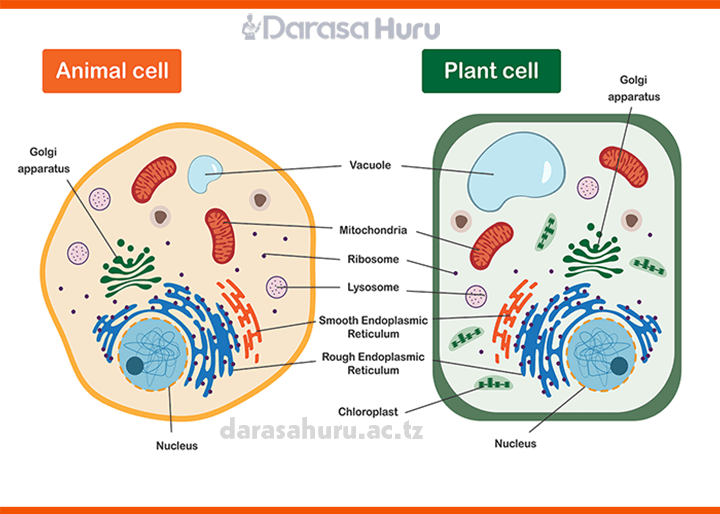
I. Similarities Between the Plant and Cell:
i. Both have cytoplasm.
ii. Both have a cell membrane.
iii. Both have a nucleus.
iv. Both have mitochondrion (power house of a cell).
II. Difference Between Plant and Animal cells
Cell Structure and Organization
Exercise
1. What are the differences between prokaryotic and eukaryotic cells?
2. Mention the structures that are found in plant but not in animal cells.
3. Draw a diagram of an animal cell and label the parts which perform the following functions.
(a) Energy production
(b) Control all the functions of the cell
(c) Suspended organelles
(d) Allow passage of some substances
CELL DIFFERENTIATION
Cell differentiation is the process by which cells are specialized to perform a particular function. Cell differentiation is also called division of labour.
Importance of cell differentiation
i. It leads to division of labour
ii. It helps the body to carry out all life processes at the same time.
iii. It makes the cell to perform a particular function.
Note: If an organism is made of only one cell, it is called unicellular. If an organism is made of many cells, it is called multicellular.
i. Tissue is a group of cells that work together to perform a particular function. An example of tissue is blood, nervous tissue, and the top layer of skin.
ii. Organ is a group of tissues that work together to perform a particular function. Examples of organs are the heart, the brain, and the skin.
iii. Organ system is a group of organs that work together to perform a particular function. Examples of organ systems are the circulatory system and the nervous system.
SPECIALIZED ANIMAL CELLS
SPECIALIZED PLANT CELLS
Chapter summary
1. The cell is the basic functional unit of life.
2. There are two main types of cells: prokaryotic and eukaryotic.
3. Animal cells and plant cells are eukaryotic cells.
4. The structures that are found in plant cells but not in animal cells are the cell wall, chloroplasts, and cell sap vacuoles.
5. Cell differentiation refers to the way cells are specialized to perform a specific function.
6. A tissue is a group of cells that perform the same function.
7. An organ is made up of various tissues that work together to perform a specific function.
8. An organ system consists of organs that work together to perform a specific function.
9. Examples of specialized animal cells are white blood cells, red blood cells, and sperm cells.
10. Examples of specialized plant cells are guard cells, root hair palisade cells.
Revision Exercise
1. One of the following is NOT a component of the cell theory:
(a) All living things are composed of cells.
(b) All cells are produced from other cells.
(c) All cells are basically similar in chemical composition.
(d) All life processes take place outside the cells.
2. One of the following is NOT a characteristie of prokaryotic cells.
(a) They have no nuclear membrane.
(b) They reproduce by binary fission.
(c) They have circular DNA.
(d) They have mitochondria.
3. Which of the following is the functional unit of life?
(a) Tissue
(b) Cell
(d) System
4. Which of the following organism has differentiated cells?
(a) Bacteria
(b) Amoeba
(c) Plants
(d) Paramecium
5. Write TRUE for correct statements and FALSE for incorrect statements in the spaces provided.
(a) A tissue comprises different organs that perform the same function.
(b) Chloroplasts and mitochondria perform similar functions.
(c) Palisade cell is one of the specidised cells in plants.
(d) A cell membrane is similar in function to a cell wall.
6. The following tenns are arranged in alphabetical order. Rearrange them into an appropriate biological sequence, staring with the lowest level. cell organ organism
7. Name the parts of the cell described in each of the following statements.
(a) The semi-pemneable membrane thar encloses the cytoplasm of a cell.
(b) A large cellular organelle that contains hereditary information.
(c) The site for respiration in the cell.
(d) A jelly-like mixture consisting mostly of water, located between the cell membrane and the nucleus,
(e) A par that protects, supports, and gives shape to plant cells.
8. Differentiate:
(a) Prokaryotic from eukaryotic cells tissue
9. Compare the structures of a plans and an animal cell as seen under the light
10. Explain what will happen if the following are removed from the plant or Maj Nucleus
(b) Cell wall
(c) Chloroplast
(d) Mitochondria
I1. Using examples of plant and animal cells, explain the meaning of cell differentiation.
12. Describe the functions of any three specialised cells in plants.











